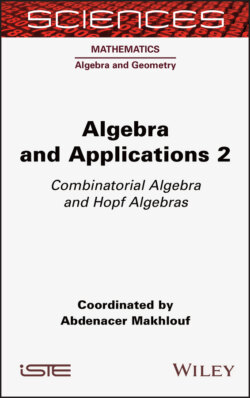Читать книгу Algebra and Applications 2 - Группа авторов - Страница 43
1.6.5. B-series, composition and substitution
ОглавлениеB-series have been defined by Hairer and Wanner, following the pioneering work of Butcher (1963) on Runge-Kutta methods for the numerical resolution of differential equations. Remarkably enough, rooted trees revealed to be an adequate tool not only for vector fields, but also for the numerical approximation of their integral curves. Butcher discovered that the Runge-Kutta methods formed a group (since then called the Butcher group), which was nothing but the character group of the Connes-Kreimer Hopf algebra ℋCK (Brouder 2000).
Consider any left pre-Lie algebra (A, ⊳), and introduce a fictitious unit 1, such that 1 ⊳ a = a ⊳ 1 = a for any a ∈ A, and consider for any a ∈ A, the unique left pre-Lie algebra morphism Fa : (T, →) → (A, ⊳), such that Fa(•) = a. A B-series is an element of hA[[h ]] ⊕ k.1 defined by:
[1.100]
where α is any linear form on (here, σ(s) is the symmetry factor of the tree, that is, the order of its group of automorphisms). It matches the usual notion of B-series (Hairer et al. 2002) when A is the pre-Lie algebra of vector fields on ℝn (it is also convenient to set Fa(∅) = 1). In this case, the vector fields Fa(t) for a tree t are differentiable maps from ℝn to ℝn called elementary differentials. B-series can be composed coefficient wise, as series in the indeterminate h, whose coefficients are maps from ℝn to ℝn. The same definition with trees decorated by a set of colors leads to straightforward generalizations. For example, the P-series used in partitioned Runge-Kutta methods (Hairer et al. 2002) correspond to bi-coloured trees.
A slightly different way of defining B-series is the following: consider the unique pre-Lie algebra morphism , such that ℱa(•) = ha. It respects the gradings given by the number of vertices and the powers of h, respectively; hence, it extends to , where is the completion of with respect to the grading. We further extend it to the empty tree by setting ∙a(∅) = 1. We then have:
[1.101]
where is the isomorphism from to given by the normalized dual basis (see section 1.6.3).
We restrict ourselves to B-series B(α; a) with α(∅) = 1. Such αs are in one-to-one correspondence with characters of the algebra of forests (which is the underlying algebra of ℋCK) by setting:
[1.102]
The Hairer-Wanner theorem (Hairer et al. 2002, Theorem III.1.10) says that the composition of B-series corresponds to the convolution product of characters of ℋCK, namely:
[1.103]
where linear forms α, β on and their character counterparts are identified modulo the above correspondence.
Let us now turn to substitution (Chartier et al. 2010). The idea is to replace the vector field a in a B-series B(β; a) by another vector field , which expresses itself as a B-series, that is, , where α is now a linear form on , such that α(∅) = 0. Here, we suppose that α(•) = 1. The following proposition is proven in Calaque et al. (2011):
PROPOSITION 1.16.– For any linear forms α,β on with α(• = 1), we have:
[1.104]
where α is the multiplicatively extended to forests, β is seen as an infinitesimal character of ℋCK, and * is the dualization of the left coaction Φ of ℋ on ℋCK defined in section 1.6.3.
The condition α(•) = 1 is in fact dropped in Calaque et al. (2011, Proposition 15): the price to pay is that one has to replace the Hopf algebra ℋ by a non-connected bialgebra with a suitable coproduct, such that ℋ is obtained as the quotient , where is the ideal generated by • – 1. The substitution product * then coincides with the one considered in Chartier et al. (2010) via natural identifications.
